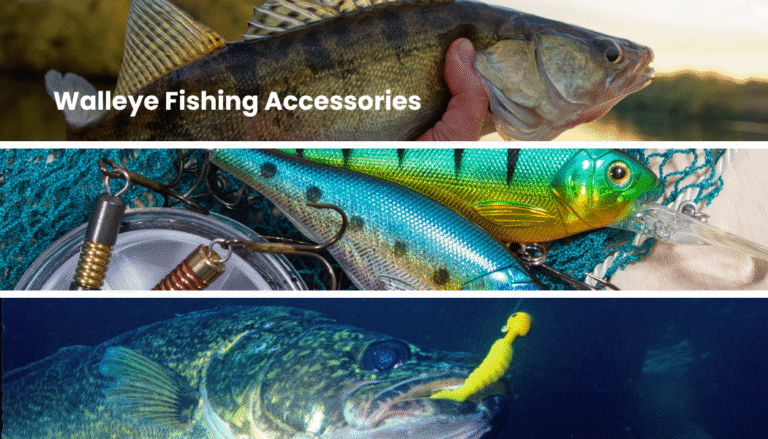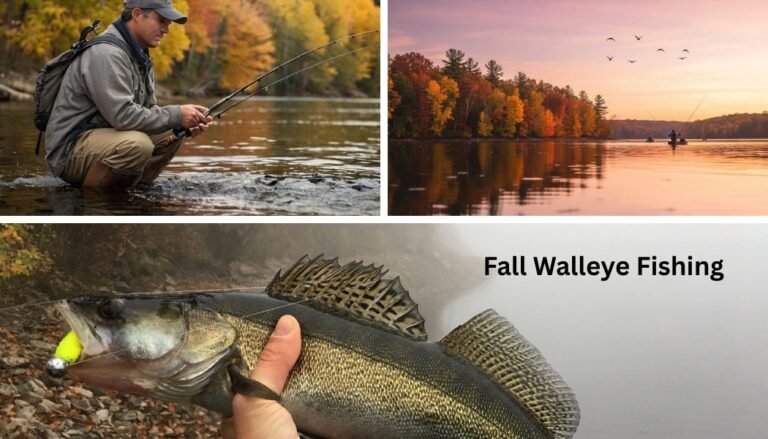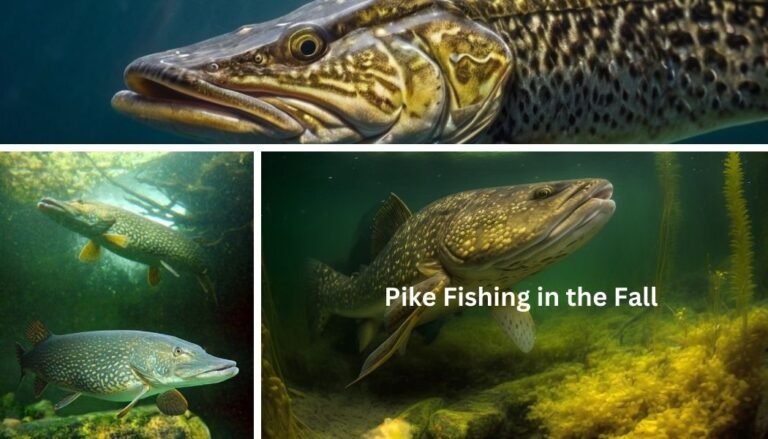Pike fishing: Catching Those Slough Sharks
Pike fishing is an exhilarating pursuit for anglers and requires a blend of knowledge, skill, and the right equipment. This comprehensive guide delves into the nuances of pike fishing, from understanding the behavior of this formidable predator to mastering various techniques and ensuring safety and conservation.
In this detailed exploration, I will cover everything you need to know to succeed in pike fishing, including essential gear, effective fishing methods, and advanced strategies. Whether you’re a seasoned angler or a novice, this guide will enhance your pike fishing experience and improve your chances of landing that trophy fish.
Understanding Pike
Habitat and Behavior
Pike, scientifically known as Esox Lucius, are freshwater fish found predominantly in the Northern Hemisphere. They are known by several names depending on the region: Pike, Northern Pike, and Slough Sharks. They inhabit a variety of water bodies, including lakes, rivers, and reservoirs, preferring clear, vegetative waters where they can ambush prey. Understanding their habitat is crucial; pike are often found in weedy shallows during spring and deeper waters during summer and winter.
Pike are solitary predators with a territorial nature. They exhibit ambush behavior, lying in wait among aquatic vegetation or structures before darting out to capture prey with their sharp teeth and powerful jaws. This predatory strategy makes them exciting yet challenging targets for anglers.

Feeding Patterns
Pike are carnivorous and eat fish, amphibians, small mammals, and birds. That is why they are referred to as slough sharks; they will eat anything smaller than themselves. They are most active during dawn and dusk, thus making these times ideal for fishing. Seasonal changes also affect their feeding patterns; in spring and fall, pike are more aggressive and actively hunt to build energy reserves.
Their feeding behavior is influenced by water temperature, with pike showing reduced activity in extreme cold or heat. Understanding these patterns can help anglers predict the best times and locations to fish for pike.
Essential Equipment
Rods and Reels
For pike fishing, a medium-heavy to heavy action rod, typically 6.5 to 8 feet in length, is crucial. This provides the strength needed to handle pike’s aggressive strikes and strong runs. Spinning reels are commonly used due to their versatility and ease of use, but bait casting reels are also effective, especially for experienced anglers. These reels should have a high line capacity, at least 200 yards, and a strong drag system to manage the power of a hooked pike. Ensure the drag is smooth and adjustable to handle sudden bursts of speed and strong pulls.
- Ugly Tech Construction
- Ugly Stik Clear Tip
- Ugly Tuff Guides
Lines and Leaders
Strong, abrasion-resistant lines are essential. Braided lines, with a test strength of 20 to 50 pounds, offer high sensitivity and durability, making them ideal for detecting bites and fighting pike. A fluorocarbon leader is crucial to prevent the pike’s sharp teeth from cutting the line. These leaders, typically 12 to 18 inches long, should match the strength of the main line, usually 20 to 30 pounds. Most people use a wire leader as it holds up better than fluorocarbon. This setup ensures the integrity of your line and increases your chances of landing the fish.
Baits and Lures
Live or dead bait such as minnows, smelt, and perch are highly effective for pike. These baits should be presented in a way (horizontally) that mimics natural prey behavior. For artificial lures, spoons, spinnerbaits, crankbaits, and soft plastics are commonly used. Spoons, with their flashy, wobbling action, attract pike from a distance. One of the most popular of all the spoons is a red and white spoon, also known as a Red Devil.
Spinnerbaits create vibration and flash, mimicking the movements of prey fish. Crankbaits can be used to cover various depths and often have built-in rattles to draw pike’s attention. Soft plastics, rigged on jig heads, can be worked slowly along the bottom or through vegetation, imitating injured fish.
Hooks and Rigs
For hooks, size and strength are critical. Treble hooks in sizes 2 to 4 are commonly used for their high hook-up rates, especially when using lures. Single hooks, such as those used in Texas or Carolina rigs, are effective for live bait and soft plastics. Ensure your hooks are sharp and durable enough to penetrate the pike’s tough mouth.
Various rigs can enhance bait presentation. The Carolina rig, with its weight and leader system, allows the bait to move naturally above the bottom, attracting pike in deeper waters. ‘Pickeral Rigs‘ are commonly used for pike when stationary bait fishing. The slip bobber rig is useful for suspending live or dead bait at specific depths, especially in weedy areas where pike hide.
Terminal Tackle
Snap swivels and leaders are essential to prevent line twists and ensure secure lure attachment. Heavy-duty snap swivels, capable of handling 50 pounds or more, are recommended. Wire leaders, typically 8 to 12 inches long, are crucial when using lures, as they prevent pike from cutting the line with their teeth. Split rings should be strong and corrosion-resistant, ensuring reliable connections between hooks, lures, and leaders.
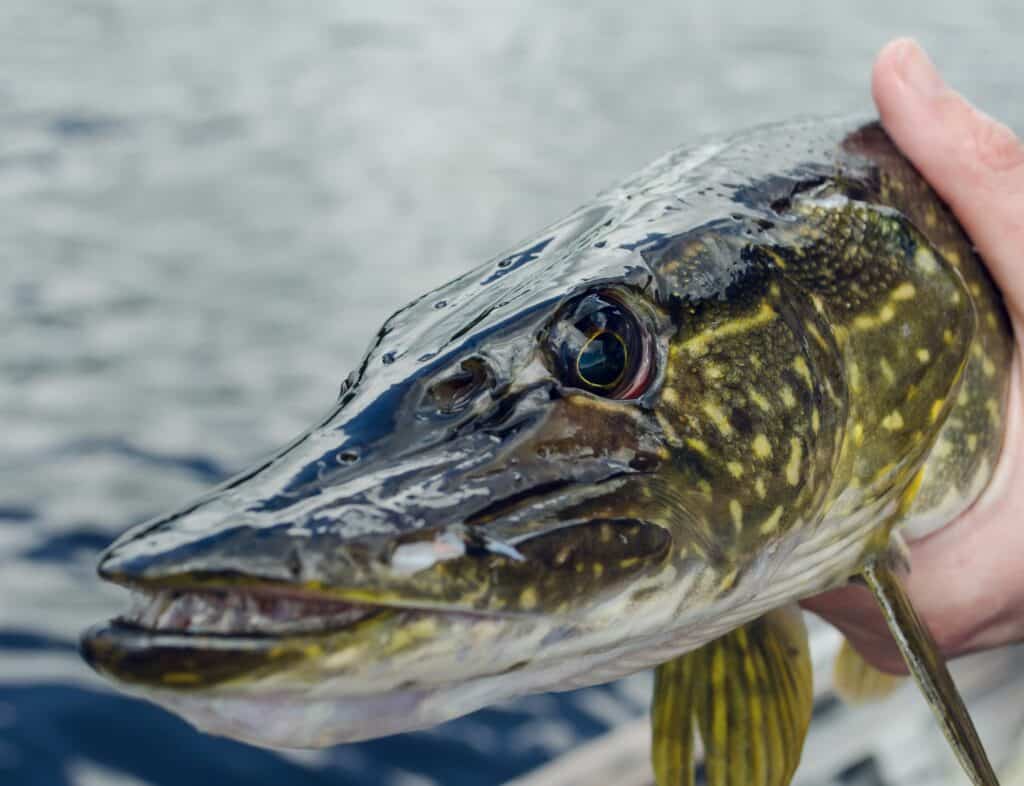
Landing and Handling Tools
A rubberized landing net minimizes injury to the fish during landing. Long-nose pliers or a dedicated hook remover are essential for safely extracting hooks from the pike’s mouth. A jaw spreader helps, as pike tend to swallow hooks deep inside their mouths and keep their mouths clamped shut. Their teeth are sharp and numerous; trust me, if they bite you, it is going to hurt. A fish gripper can help handle larger pike securely. A measuring tape or ruler is useful for checking if the catch meets legal size requirements.
- What You Get – 1*Fishing Plier (Totally Length: 6.5inch, Weight: 2.82oz ); 1* Fish Lip Gripper with…
- Multi-Functional Fishing Pliers – This fishing plier can easily Split Rings, Remove Hooks, Strip…
- Fish Lip Gripper – The fish lip grip tool has a strong grip that easily controls the big fish, easy…
Storage and Transport
A tackle box with organized compartments keeps all your gear accessible and protected. A rod holder or tube helps transport rods safely, preventing damage during travel. A quality cooler or live well is essential for keeping live bait in optimal condition.
Clothing and Accessories
Weather-appropriate clothing, including waterproof jackets and pants, keeps you comfortable during long fishing sessions. Polarized sunglasses reduce glare on the water surface, improving your ability to spot pike and navigate safely. Gloves that could protect your hand from the pike’s teeth when unhooking the pike. A hat with a brim and sunscreen protects you from the sun’s harmful rays.
Each piece of fishing equipment plays a vital role in ensuring a successful and enjoyable pike fishing experience. Proper preparation and selection of gear enhance your ability to target and land pike effectively.
Fishing Techniques
Casting and Retrieving
Casting and retrieving is a fundamental technique in pike fishing. It involves casting your lure into potential pike habitats and retrieving it at various speeds and patterns. This technique mimics the movement of prey, enticing pike to strike. Start by casting near weed edges, submerged structures, and drop-offs where pike often lurk.
Vary your retrieval speed: a slow, steady retrieve works well in colder water, while a faster retrieve can trigger strikes in warmer conditions. Incorporate pauses and twitches to make the lure behave like an injured fish, which is particularly attractive to pike.
If casting from a boat and you miss strike near your boat, do a figure 8 with your lure several times. This maneuver will usually cause the pike to try and hit the lure again.
Trolling
Trolling is an effective method for covering large water areas and locating pike. This technique involves dragging lures or baits behind a moving boat at controlled speeds. Adjust the trolling speed to match the lure type and water conditions; speeds between 2 to 4 mph typically work well for pike. Use downriggers or planer boards to maintain the desired lure depth, ensuring it runs just above the weeds or near the bottom where pike hunt. Experiment with different lure types and colors to find what pike are responding to on any given day.
Fly Fishing for Pike
Fly fishing for pike requires specialized equipment and techniques. Use a heavy-duty fly rod, typically 9 to 10 feet in length, with a weight rating of 8 to 10. Large arbor reels with strong drag systems are necessary to handle pike’s powerful runs. Streamers and large flies, resembling baitfish, frogs, or small mammals, are ideal. Casting accuracy is crucial; aim to land the fly near weed beds, fallen trees, or rocky outcrops. Strip the fly line in varying lengths and speeds to mimic the erratic movements of prey. Setting the hook firmly is important due to the pike’s hard mouth.
Ice Fishing for Pike
Ice fishing for pike is popular during winter months. It requires specific gear, including ice augers, tip-ups, and ice rods. Start by drilling holes near drop-offs, weed beds, and other structures where you will likely find pike. Use live or dead bait, such as shiners or suckers, suspending them at varying depths using tip-ups. Jigging with spoons or soft plastics can also attract pike. Use electronics like fish finders to monitor pike activity and adjust bait depth accordingly. Be patient and attentive, as pike bites can be subtle under the ice.
Drift Fishing
Drift fishing involves allowing the boat to drift naturally with the current or wind while casting and retrieving lures. This technique covers a broad area and is effective in rivers and large lakes. Position the boat to drift along weed edges, drop-offs, or rocky structures where pike are likely to ambush prey. Use lures that can be worked at varying depths, adjusting your retrieve speed and style to match the drift speed. This method allows for a natural presentation and can be particularly effective in catching wary pike.
Float Fishing
Float fishing uses a float or slip bobber to suspend the bait at a specific depth, making it easier to detect bites. Set the float to keep the bait just above the weeds or near the bottom. Use live or dead bait such as minnows or smelts. Cast the setup near likely pike haunts such as weed beds, submerged logs, or drop-offs. Watch the float closely for any movement, indicating a bite. Strike quickly to set the hook, as pike often strike hard and fast.
Bottom Fishing
Bottom fishing targets pike lurking near the lake or riverbed. Use a weight to anchor your bait on the bottom, and employ dead bait like mackerel or herring. This technique works well in colder months when pike are less active and stay near the bottom. Cast your rig into deep holes, near structures, or at the base of drop-offs. Wait patiently and keep the line taut to feel for any bites. Pike often take the bait and move off slowly, giving you time to set the hook.
Using Dead Baits
Dead bait fishing is effective, especially when pike are less active in colder water. Use fish like smelt, mackerel, or herring, presenting them on a bottom rig or under a float. The bait’s scent and appearance attract pike. Cast the bait into areas with structure or along weed edges. Allow the bait to sit and monitor for any signs of a strike. You can set the hook once the pike has moved off with the bait, indicating a solid take.
Each technique requires understanding pike behavior and adapting to environmental conditions. Mastering these methods increases your chances of a successful pike fishing trip.
Advanced Strategies
Seasonal Adjustments
Adjusting your fishing strategies based on seasonal changes is critical for pike fishing success. In spring, pike are in shallow, warm waters for spawning. Target these areas using shallow-running lures or live bait near weed beds and inlets. During summer, pike retreat to deeper, cooler waters. Use deep-diving crankbaits, weighted jigs, or troll with downriggers to reach these depths. In fall, pike return to shallower areas to feed aggressively before winter. This is a prime time to use large, flashy lures and live bait near weed edges and rocky structures. Winter pike can be found under the ice near drop-offs and structures. Use tip-ups with live bait and jigging spoons to entice bites.
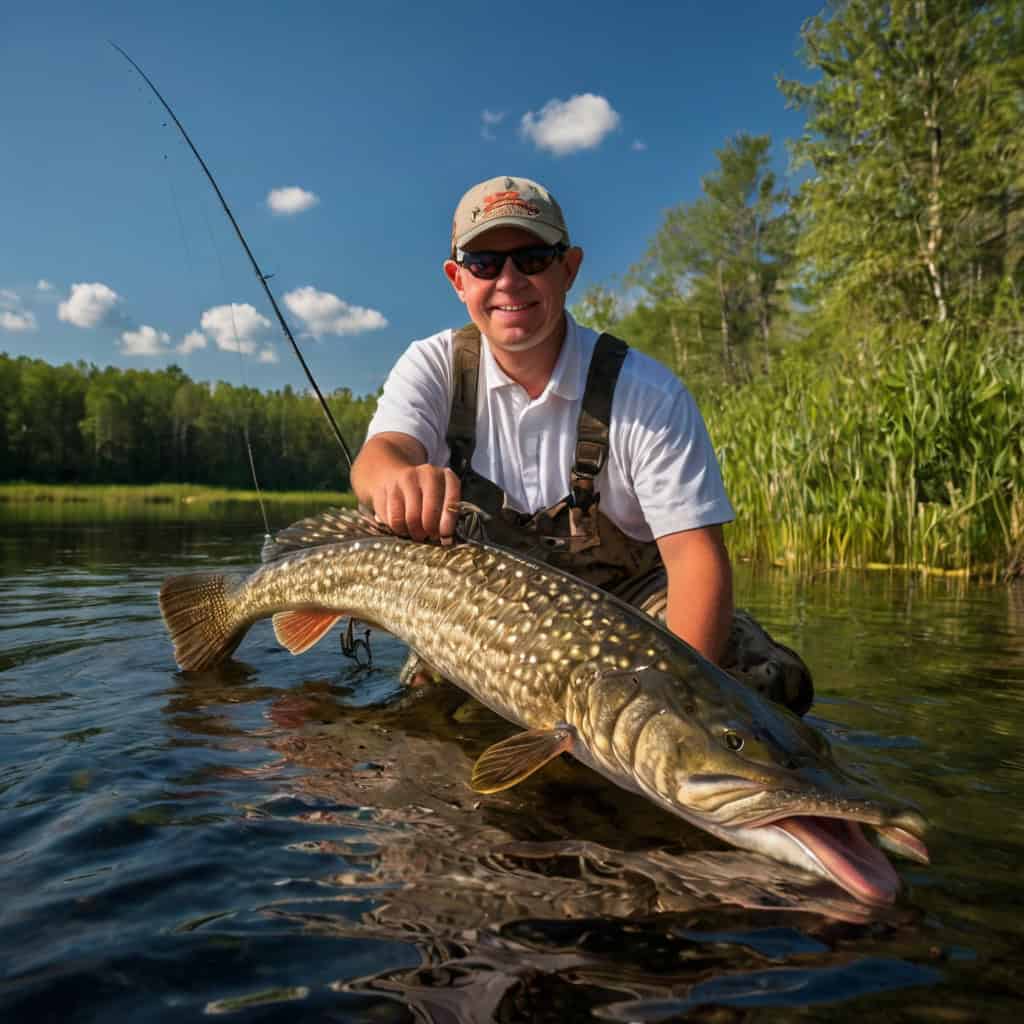
Reading Water Conditions
Reading water conditions helps identify productive fishing spots. Clear water requires natural-colored lures and subtle presentations. In stained or murky water, use bright, flashy lures to increase visibility. Temperature changes influence pike activity; they prefer water temperatures between 60-70°F. Monitor water temperature with a thermometer or electronics. Current and wind can also affect pike locations. Pike often face into the current to ambush prey, so position your casts accordingly. Wind can push baitfish into specific areas, attracting pike, so fish the windward side of the lake or river.
Using Electronics
Electronics like fish finders and GPS units enhance your ability to locate pike. Fish finders help identify schools of baitfish and underwater structures such as drop-offs, weed beds, and submerged logs. Use the fish finder to mark these locations and determine the depth at which pike are holding. GPS units allow you to mark productive spots, creating a map of key fishing areas. They also help navigate large water bodies and return to successful locations on future trips. Combining these tools with traditional fishing knowledge increases your chances of finding and catching pike.
Bait Presentation
Effective bait presentation is crucial for attracting pike. Ensure your lures mimic the natural movement of pike prey. For example, erratic retrieves with jerk baits can be used to imitate injured fish. When using live bait, hook the baitfish through the back or lips to allow natural swimming motions. Adjust your presentation based on pike behavior and water conditions. In colder water, a slow and steady presentation is more effective, while in warmer water, a faster, more aggressive retrieve can trigger strikes.
Matching the Hatch
Matching the hatch involves using lures and baits that resemble the natural prey in the area. Observe the local forage species and choose lures that mimic their size, color, and behavior. This strategy is particularly effective in clear waters where pike rely on sight to hunt. In environments with abundant perch, for instance, use perch-colored crankbaits or soft plastics. Matching the hatch increases the likelihood that the pike will mistake your lure for a real meal.
Stealth and Patience
Stealth and patience are essential, especially in clear or heavily pressured waters. Approach fishing spots quietly to avoid spooking pike. Use long casts to reach areas without disturbing the water directly above the fish. When fishing from a boat, minimize noise and anchor at a distance from your target area. Patience is key; allow time for pike to investigate your lure or bait, especially if they are less active due to weather conditions or time of day.
Adaptation and Experimentation
Adaptation and experimentation can lead to greater success. If a particular lure or technique isn’t working, try different colors, sizes, or retrieval methods. Pay attention to what triggers strikes and adjust your approach accordingly. Keep track of successful patterns and conditions in a fishing journal to refine your strategies over time. Being adaptable ensures you can respond to changing conditions and pike behavior effectively.
Each advanced strategy requires a deep understanding of pike behavior and the ability to adjust to varying conditions. Implementing these strategies enhances your ability to catch pike consistently.
Safety and Regulations
Personal Safety
Fishing for pike, especially in remote or challenging environments, requires attention to personal safety. Always wear a life jacket when fishing from a boat, and ensure you have necessary safety gear such as a first aid kit, signaling devices, and a reliable means of communication. Be mindful of weather conditions and water temperatures, especially during ice fishing.
Conservation Practices
Practicing catch and release is crucial for sustaining pike populations. Use appropriate gear to minimize injury to the fish, and handle them with care to ensure their survival upon release. Familiarize yourself with local regulations regarding size (slot limits) and bag limits to support conservation efforts.
Local Regulations
Adhering to local fishing regulations is essential. These regulations vary by region and dictate legal fishing methods, seasons, and limits. Always check the regulations to avoid enforcement action from local wildlife agencies or fishing authorities. These regulations are put in place to support sustainable fishing practices.
Field Tips
Handling and Releasing Pike
Proper handling and releasing techniques are vital for the welfare of pike. Use a rubberized landing net to minimize injury, and handle the fish with wet hands or gloves. Remove hooks carefully using long-nose pliers or a dehooking tool, and promptly release the fish into the water.
Common Mistakes and How to Avoid Them
Avoid common mistakes such as using inappropriate gear, neglecting to check local regulations, or fishing at the wrong times. Overcoming these pitfalls involves thorough preparation, understanding pike behavior, and adapting techniques based on environmental conditions.
If you plan to keep a pike to eat, only keep the pike caught in cold water, as the flesh will be firm. Pike flesh tends to get mushy as water temperature goes up. Filleting pike can be tricky due to their Y bones. Many people complain that pike are bony. Watch a video on how to fillet them properly.
Success Stories
Notable Pike Fishing Experiences
Learning from notable pike fishing experiences can provide valuable insights. Anglers often share stories of their biggest catches, challenging conditions, and the techniques that worked for them. These stories not only inspire but also offer practical advice for improving your fishing skills.
Lessons Learned from Experts
Experts in pike fishing have accumulated a wealth of knowledge over years of experience. They emphasize the importance of patience, adaptability, and continuous learning. Paying attention to their tips and adapting them to your fishing style can significantly enhance your success.
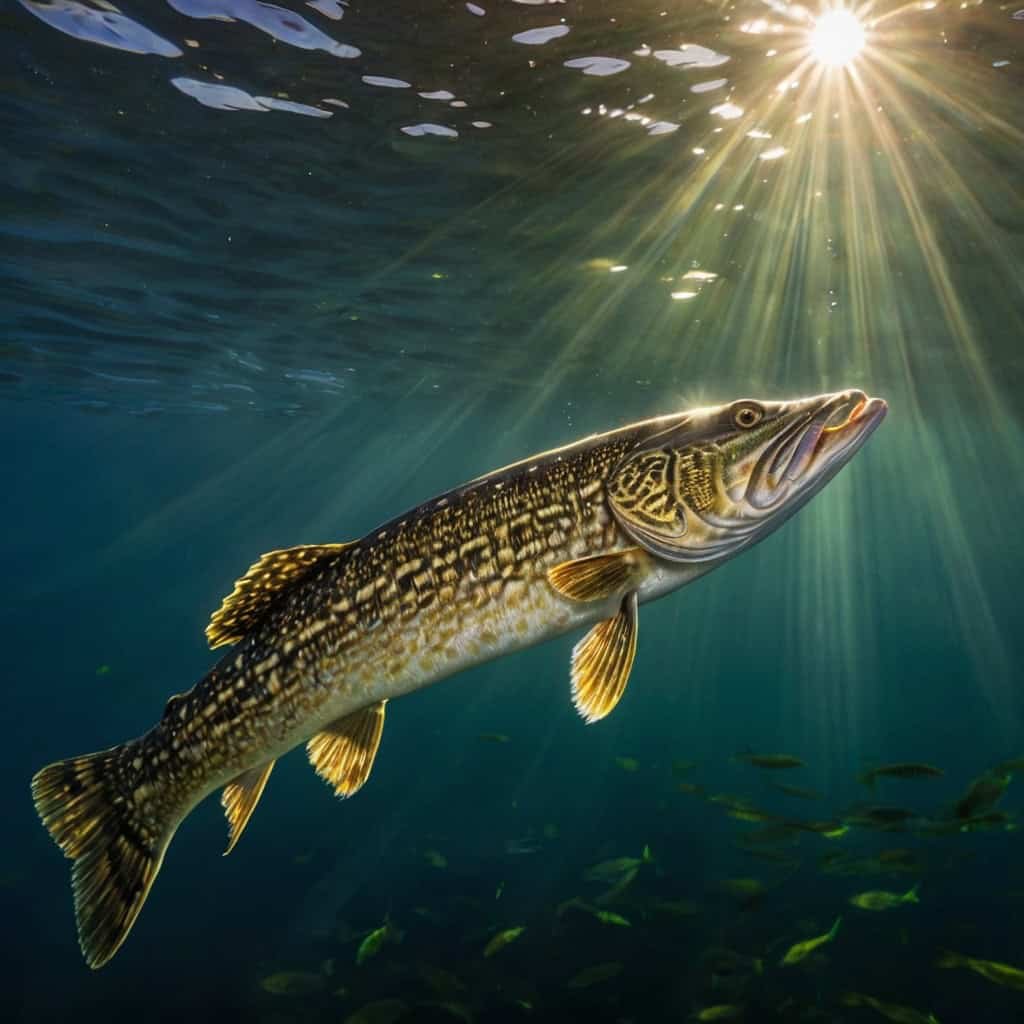
Reflections on Pike Fishing
The Thrill of the Chase
Pike fishing is a rewarding and challenging pursuit that demands a blend of knowledge, skill, and adaptability. By understanding pike behavior, selecting the right equipment, and mastering various techniques, anglers can significantly improve their chances of success. The thrill of the chase, the anticipation of the strike, and the satisfaction of landing a pike are experiences that resonate deeply with those who fish for this formidable predator. This comprehensive guide has provided the tools and insights needed to enhance your pike fishing endeavors, ensuring you are well-prepared for the diverse conditions and scenarios you may encounter.
Connecting with Nature and Catching More Pike
Ultimately, pike fishing offers more than just the catch; it provides a profound connection to nature and a sense of accomplishment. Whether fishing in the serene stillness of a winter lake or the bustling activity of spring shallows, the pursuit of pike brings moments of peace, excitement, and reflection. Embracing conservation practices and respecting local regulations ensures that pike populations remain healthy and sustainable for future generations. With the knowledge and strategies outlined in this guide, you are now equipped to catch pike and fully appreciate the rich experience that pike fishing offers.
FAQ Section
Are there specific regulations for pike fishing?
Yes, regulations vary by region and can include size limits, bag limits, and seasonal restrictions. Always check with local authorities before fishing.
What types of lures are most effective for pike?
Effective lures include spoons, spinnerbaits, crankbaits, and soft plastics. Bright colors and larger sizes are often more attractive to pike.
What is the best time of year to fish for pike?
The best times are typically during the spring and fall when pike are more active and feeding aggressively. However, with the right techniques, pike can be caught year-round.
How can I safely handle and release a pike?
Use a rubberized landing net, handle the fish with wet hands or gloves, and remove hooks carefully with long-nose pliers. Release the fish promptly back into the water.
Can I fish for pike in the winter?
Yes, ice fishing for pike is popular in winter. Specialized equipment such as ice augers, tip-ups, and ice rods are required, and live bait is often used.
Disclaimer: This blog post contains affiliate links




